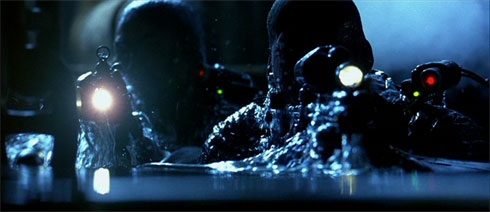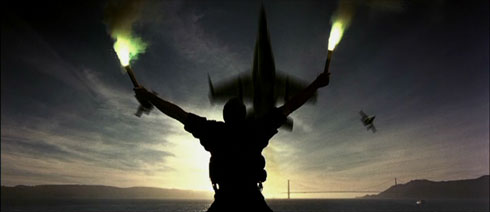A part of this viewing list: Criterion Collection Spine #108: Michael Bay’s The Rock.

Oh God. I can’t really believe that The Rock [and Armageddon] are on the Criterion Collection list. But then, Michael Bay has a contract with them. Anyway, their eccentricity as films on this list is a good opportunity to apply critical analysis to a mainstream blockbuster, something I rarely do. The last movie I reviewed was Down By Law, and you’d be hard pressed to find a movie that is more dissimilar to it than The Rock.
For starters, it is a film about breaking into a prison instead of out of one. Secondly, it has all of the firepower of the Hollywood production colossus behind it. I’m going to split the review into two portions, the first about the cultural components of the film, and the second about its mechanics and how they tie together. This will probably be a long review.

The Rock, and many films like it, was designed to appeal to directly to an American male’s subconscious understanding of what it means to be an American male. It sort of grabs for a boyhood idea of playing soldier while simultaneously offering a more sophisticated understanding of the military complex. The film, again like many films like it, is also necessarily conservative [in a political sense] in its portrayal of the military use of violence. This is a tough path to tread, but it works well enough to a cursory glance [which, as I’ll argue, is all you ever have time to do in a film like this]. Nicholas Cage’s character, Stanley Goodspeed, acts as a magnet for the subconscious projection of boyhood military fantasy. Although he is a chemical weapons specialist, he’s also just some dude with a desk job, and one unused to violence. Yet he ends up equipped with all kinds of fancy fighting gear and goes along with a Navy SEAL team and a British SAS agent to infiltrate an island fortress held by rogue militants. This satisfies the id’s desire to act out repressed fantasies [Freud is useful here, but maybe not exact]. We’ve still got the super-ego to think about, and cultural taboos as well.
Enter the villains. Ed Harris’s character is a general, a legend among the military community, and now he’s gone a bit rogue because he is dissatisfied with his country’s behavior regarding Force Recon soldiers abandoned in enemy territory during his tenure as a black operative. He steals some crazy nasty poison and holes up on Alcatraz with 81 hostages, threatening to kill most of San Francisco unless the government agrees to pay reparations to the families of 83 of his lost brothers in arms. A noble cause it seems, but we’ve got a few hundred thousand innocent civilians to think about. This adds the tough decision of duty to the freewheeling adventure that I’ve already described. So this can’t be just a simple blow’em up and God’ll sort’em out film, the villain is one of our own and must be understood first, and stopped without violence if possible.

There are additional motivations to think about, Goodspeed has a knocked up girlfriend, Sean Connery’s James Mason wants to get to know his daughter, and FBI director Womack wants Mason sent back to prison for life, but the key to this film is not in the careful construction of the storyline, but in its visual application on the screen. The key, as I mentioned above, is to not give the viewer time to process the story, but enough time to hold it all on a superficial level. I suppose an appropriate analogy would be between ROM and RAM; the viewer can’t really store information for retrieval at a later time, but must keep it in the RAM of their mind for the entire movie.
In order to accomplish this, Bay, Bruckheimer and company rely on fast-cutting, extremely shallow depth-of-field, and a preponderance of close-up and dramatic camera-work to keep a viewer stimulated like a lab mouse that keeps hitting the crack button. Except in this case they film hits it for us. On the rare times we get a long shot, it is usually an extreme long shot, from a helicopter or somesuch, it is almost as if the distance between a plain Americain and an ELS doesn’t exist. That’s why I put the shot of Connery and Forlani up above; as far as I could tell, it was the only standard long shot in the entire film. The Rock is perfect for the attention deficit disordered, and those who can process images quickly, almost subliminally. While as movies go, it isn’t anything spectacular, the careful construction of every aspect, the obvious weighing of each and every cog, widget, sprocket-hole and facial expression is almost mind-bogglingly impressive. Certainly something you’d only expect Hollywood to be capable of.

• Criterion Essay by Roger Ebert.
• National Park Service site on Alcatraz.
• Alcatraz History